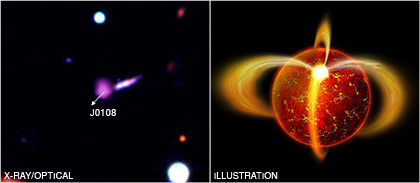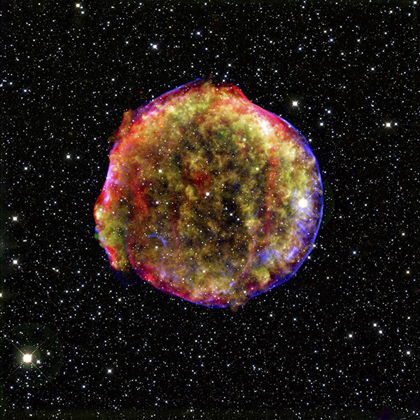Submitted by chandra on Wed, 2009-03-25 14:20
This optical and infrared image from the Digitized Sky Survey shows the crowded field around the micro-quasar GRS 1915+105 (GRS 1915 for short) located near the plane of our Galaxy. The inset shows a close-up of the Chandra image of GRS 1915, one of the brightest X-ray sources in the Milky Way galaxy. This micro-quasar contains a black hole about 14 times the mass of the Sun that is feeding off material from a nearby companion star. As the material swirls toward the black hole, an accretion disk forms.
Submitted by chandra on Fri, 2009-03-20 11:48
You may have noticed that NASA is running an event mirroring the annual extravaganza that is the NCAA basketball tournament. Instead of selecting the basketball teams you think will win (I'm rooting for a certain Big 10 team myself), you vote for your favorite NASA mission.

Submitted by chandra on Wed, 2009-03-18 15:08
We've talked about one of our favorite IYA2009 projects here before - "From Earth to the Universe" - and now we want to give you an update. As of this month, FETTU, as we lovingly call it, is a reality. In the US, FETTU is currently appearing in the Tucson international airport in the baggage claim area.
Submitted by chandra on Wed, 2009-03-11 13:34
Dr. Randall Smith joins us this week for our "Meet an Astronomer" segment. Randall has worn several astronomical hats over the years, but right now he's putting most of his effort into working on the International X-ray Observatory. For those of you who haven't heard of it, IXO as it's known, is the
Submitted by chandra on Wed, 2009-03-11 13:13
This composite image of the Medusa galaxy (also known as NGC 4194) shows X-ray data from NASA's Chandra X-ray Observatory in blue and optical light from the Hubble Space Telescope in orange. Located above the center of the galaxy and seen in the optical data, the "hair" of the Medusa -- made of snakes in the Greek myth -- is a tidal tail formed by a collision between galaxies. The bright X-ray source found towards the left side of Medusa's hair is a black hole.
Submitted by chandra on Wed, 2009-03-04 09:53
In the next installation of our new "Meet an Astronomer" series here on the Chandra blog, we introduce you to Dr. Peter Edmonds. Peter has been a part of our Education and Public Outreach group since 2003 and he has been an invaluable member of our team ever since. He helps find, track and develop the Chandra stories that we publicize, and he's instrumental in striking the right balance between scientific detail and public understanding.
Submitted by chandra on Thu, 2009-02-26 11:15

The composite image on the left shows an image from NASA's Chandra X-ray Observatory in purple and an optical image from the European Southern Observatory's Very Large Telescope (VLT) in red, blue and white. The Chandra source in the center of the image is the ancient pulsar PSR J0108-1431 (J0108 for short), located only 770 light years from us. The elongated object immediately to its upper right is a background galaxy that is unrelated to the pulsar. Since J0108 is located a long way from the plane of our galaxy, many distant galaxies are visible in the larger-scale optical image.
Submitted by chandra on Wed, 2009-02-25 13:04
NASA announced today the selection of its 2009 Fellows, who are scientists who were recently (that is, since Jan. 1, 2006) awarded PhDs in astronomy, physics, or a related field. These new fellows can do research at any host institution in the US that they choose, and they represent some of the best and brightest in the field.
Submitted by chandra on Wed, 2009-02-18 13:45
This composite image of the Tycho supernova remnant combines X-ray and infrared observations obtained with NASA's Chandra X-ray Observatory and Spitzer Space Telescope, respectively, and the Calar Alto observatory, Spain. It shows the scene more than four centuries after the brilliant star explosion witnessed by Tycho Brahe and other astronomers of that era.

Submitted by chandra on Tue, 2009-02-10 09:56
A few weeks ago, we told you that Chandra was going to start introducing video into our blog. We've done some minor dabbling so far, but now we're stepping it up a bit. Today we are posting our first attempt at what we're calling (at the moment) "Meet an Astronomer." The idea is to do a quick interview with a scientist to give a small peek into their world. Let's face it, scientists - and science itself - can seem a little off-putting. This hopefully will make both of those feel a little more accessible and personal.
Pages